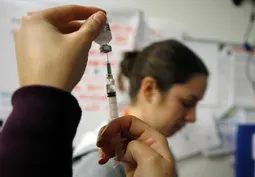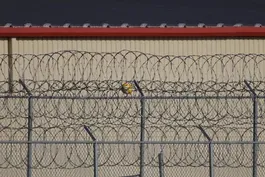
How NWS staffing shortages could put lives at risk
Clip: 5/3/2025 | 4m 48sVideo has Closed Captions
How staffing shortages at the National Weather Service could put lives at risk
The Trump administration’s dismissals of hundreds of experts compiling a key report on climate change is only the latest in a series of science-related rollbacks and cuts. That includes job cuts at the National Weather Service, where an Associated Press analysis found a 20 percent vacancy rate in nearly half its forecast offices. John Yang speaks with AP science writer Seth Borenstein for more.
Problems with Closed Captions? Closed Captioning Feedback
Problems with Closed Captions? Closed Captioning Feedback
Major corporate funding for the PBS News Hour is provided by BDO, BNSF, Consumer Cellular, American Cruise Lines, and Raymond James. Funding for the PBS NewsHour Weekend is provided by...

How NWS staffing shortages could put lives at risk
Clip: 5/3/2025 | 4m 48sVideo has Closed Captions
The Trump administration’s dismissals of hundreds of experts compiling a key report on climate change is only the latest in a series of science-related rollbacks and cuts. That includes job cuts at the National Weather Service, where an Associated Press analysis found a 20 percent vacancy rate in nearly half its forecast offices. John Yang speaks with AP science writer Seth Borenstein for more.
Problems with Closed Captions? Closed Captioning Feedback
How to Watch PBS News Hour
PBS News Hour is available to stream on pbs.org and the free PBS App, available on iPhone, Apple TV, Android TV, Android smartphones, Amazon Fire TV, Amazon Fire Tablet, Roku, Samsung Smart TV, and Vizio.
Providing Support for PBS.org
Learn Moreabout PBS online sponsorshipJOHN YANG: The Trump administration's dismissal of hundreds of scientists and experts compiling a key report on climate change is only the latest in a series of science related rollbacks and cuts that includes job cuts.
At the National Weather Service, an Associated Press analysis found a 20 percent vacancy rate in nearly half its forecast offices.
AP Science writer Seth Borenstein wrote that story.
Seth 20 percent.
How does that compare to past years or to what's normal?
SETH BORENSTEIN, Science Writer, The Associated Press: So four years ago, about the same time period in March, it was about 10 percent.
A year before it was 12 percent.
So that's a huge jump.
And when you talk to meteorologists, they sort of have a critical level they consider for an office vacancy, it's 20 percent.
JOHN YANG: How is the ultimate consumer of their product, the American public, how are they going to feel the difference?
SETH BORENSTEIN: You're going to see some forecasts, what they call degraded.
They may not be as good in an emergency.
There are some concerns about whether people will be warned fast enough and well enough.
If you have radar and counties and tornadoes going everywhere and you only have one set of eyes, something may be missed.
The most concrete thing we can see right now is weather balloons.
Weather balloons sound very low tech, but they are sort of the key in weather forecasts.
It brings measurements from the atmosphere and the ground and it's sort of the glue to everything.
And normally the weather Service puts out 100 balloon launches twice a day.
So since this has happened, about 17 different stations are not launching either at all or just once a day.
Four years ago, that was only nine stations.
It means all the information that goes into your forecast, which goes into your apps or your television forecasts, all that information is just a little bit poor, forecast a little weaker, but it's really going to start to affect us in about a month in hurricane season.
JOHN YANG: What do people say about this?
Researchers are predicting this is going to be an above average hurricane season.
Did anyone you talk to express concern about that?
SETH BORENSTEIN: Everyone seems to express some concern.
Some of the cuts in jobs included people who fly into hurricanes to get more information.
Some of the best information you want from a hurricane is inside the hurricane.
And I was talking to a former weather service director who said when there's a hurricane brewing, they actually launched more weather balloons along the northern plains of the United States, a place you wouldn't even think about.
But that's where most of these cuts have been happening.
JOHN YANG: I mean, what other things that are usually done not being done?
I'm off season of the Hurricane Center.
I know they usually work on modeling models to help them predict and forecast.
SETH BORENSTEIN: Models are supposed to improve every year.
For example, in the last 10 years, they have cut the error for hurricane track forecasts nearly in half.
In many cases, they're forecasting it better.
And it's about just in time because with climate change, we are seeing many more rapidly intensifying storms.
But when we're talking about, you know, sort of our daily forecasts now, those will go backwards.
It's almost like you're going back 10, 20 years.
Think of it, if you picked up a pair of glasses you used to wear 20 years ago and put them on, you can see some, you know, okay, but not quite as well, and things will get lost.
The former NOAA administrator Rick Spinrad said to me that he worries about in the last few years where we've had more wildfires.
The weather service has been assigning meteorologists just to big fires.
They're called incident meteorologists.
They save firefighters lives.
They can't do that anymore.
Every living National Weather Service former director signed a letter saying lives are at risk.
This week after my story, another 300 people are leaving the weather service.
JOHN YANG: I know you reached out to the weather service to ask them for comment.
What happened.
SETH BORENSTEIN: They said they are doing the best they can.
They are still protecting lives.
And that's right when there's something big happening, they're going to run to it and they're going to work overtime.
And that's what's been happening this year.
We've had more than 700 tornadoes so far, second most on record.
People stay, they work harder, they leave their families.
But you can only stretch a balloon so far.
JOHN YANG: AP Science Writer Seth Borenstein, thank you very much.
SETH BORENSTEIN: My pleasure.
How this Utah studio supports artists with disabilities
Video has Closed Captions
Clip: 5/3/2025 | 5m 32s | Artists with disabilities let their creativity soar at this Utah studio (5m 32s)
How vaccine hesitancy may be driving pediatric flu deaths
Video has Closed Captions
Clip: 5/3/2025 | 4m 37s | How vaccine hesitancy may be driving a spike in pediatric flu deaths (4m 37s)
News Wrap: Warren Buffett criticizes using trade as a weapon
Video has Closed Captions
Clip: 5/3/2025 | 2m 59s | News Wrap: Warren Buffett warns against U.S. using trade as a weapon (2m 59s)
NYT finds no link between many deportees and Tren de Aragua
Video has Closed Captions
Clip: 5/3/2025 | 5m 45s | NYT investigation finds no evidence linking many deported Venezuelans to Tren de Aragua (5m 45s)
Providing Support for PBS.org
Learn Moreabout PBS online sponsorshipSupport for PBS provided by:
Major corporate funding for the PBS News Hour is provided by BDO, BNSF, Consumer Cellular, American Cruise Lines, and Raymond James. Funding for the PBS NewsHour Weekend is provided by...















